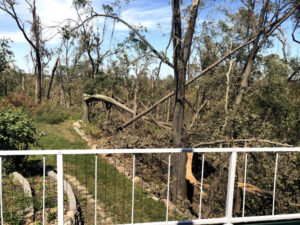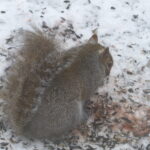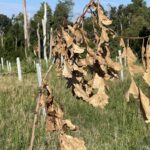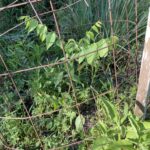Squirrels: Free Tree Planters
Our neighborhood squirrels proved they are the best tree planters.

We lost most of our mature trees in the 2020 Derecho.
An August 2020 derecho tore through Iowa pushing 140-mile-an-hour wind against trees and buildings. Trees by the hundreds of thousands tumbled to the ground. Winding Pathways wasn’t spared. We lost most of our firs, oaks, hickories, and cottonwoods. The devastation in nearby Faulkes Heritage Woods was even worse.
Almost immediately, shocked people took action. Government forestry departments, aided by tree planting nonprofits, and private citizens unleashed their shovels and planted thousands of trees. So did the squirrels. Well, not really. People planted trees.

Squirrels bury nuts in caches to retrieve them later.
Squirrels planted nuts and acorns.
Then three seasons of drought followed. Once planted, most trees were not tended as they need to be. So, many human-planted trees shriveled in the heat and dryness, while the nuts buried by squirrels sprouted and the new trees were flourishing.
But why?
We have theories. A human-planted tree seedling needs plenty of moisture to keep its trunk and new leaves hydrated. Sparse roots must pull water from the ground and send it upward. That’s a tough job in a wet year. Come drought it’s nearly impossible.
Squirrels did better. These industrious rodents don’t mean to create new trees. They’re simply storing nuts underground so they have enough fat and protein-rich food to tide them through winter. All they need to do is dig up a nut when hunger calls. Squirrels overfill their larder, burying more tasty nuts than they’ll ever need. Unfortunate squirrels are eaten by hawks, foxes, owls, or humans, but the nuts they’d buried remain patiently waiting for spring’s warmth to germinate.
Sprouting nuts grow roots able to pull scarce moisture from the soil and send it to new baby leaves poking through the ground.
As we walked through July 2023’s dry woods we sadly see human-planted trees shriveled up and dead, while nearby a new generation of tiny walnut, oak, and hickories is rising from nuts planted by industrious squirrels.
- Newly planted trees need watering.
- This squirrel planted walnut seedling sprouted just this year in spite of the drought.
Squirrels Don’t Plant All The Trees
Squirrels are the best friends of nut-bearing trees, but other tree species can’t rely on the furry rodents. Cottonwoods, for example, produce millions of seeds too tiny for squirrel food. So, the trees grow cottony fluff that floats seeds to distant places. If one lands in a patch of moist bear soil a fast-growing cottonwood sprouts. Maples have helicopter-like seeds that whirl a gig away from the parent to sprout a ways away.
Pity the poor Osage Orange tree that grows huge citrus-smelling balls containing hidden seeds. Many folks call them hedge apples. A tree must get its seeds away from its own shade. Squirrels do the job for oaks. The wind for cottonwoods. Massive mastodons once munched on Osage Orange hedge apples, wandered off, digested the pulp, and pooped out the seeds. When these massive elephants went extinct the tree lost its partner and saw its native range shrink from much of North America to a tiny spot down south.
Nature provides many ways for trees to reproduce and the results are often superior to what humans can do. We appreciate the squirrels that plant nuts many of which sprout into healthy native trees. Thanks, squirrels!




A line of gnarled Osage Orange trees borders Walford Road a half block from our house. The branches are now dotted with small hedgeapples that have a few more months to grow before the strong autumn winds blow them onto the ground. When we pass by them on our walk, we enjoy “bowling” the hedgeapples down the road to see whose ball travels the farthest before breaking apart or rolling into the sunny ditch, where its seeds might produce a new Osage Orange tree.
Neat observation, Sheri.
Enjoyed the story of how nature grows new trees. There are many new trees growing here seeds and acorns brought in by critters and birds. Some are growing in my vegetable garden so transplant them around the property in the hopes they will grow tall and strong and provide shelter for my critters and birds. Enjoy the late summer.
In some blog I saw, it was mentioned if you decide to buy trees or bushes try to get the smallest size as those small sprouts are babies just like little kids and they spurt their growth. Things that are more mature are already slowing down in their growth as well not taking transplanting shock well. Thanks for this nice reminder but I wish I could train my rodent friends to plant those trees away from my flower gardens.😁
HaHaHa! Sue, that is quite the request of the rodents! Your observation is interesting on size of trees and spurts of growth and slowing down. M~
Great article! go squirrels go!!
Thanks, Jody. Hope all well your way.
Late to this article but ain’t Mother Nature (and squirrels) just grand! And aren’t The Pattersons the most observant and best interpreters of her!
Thanks, Sigrid!